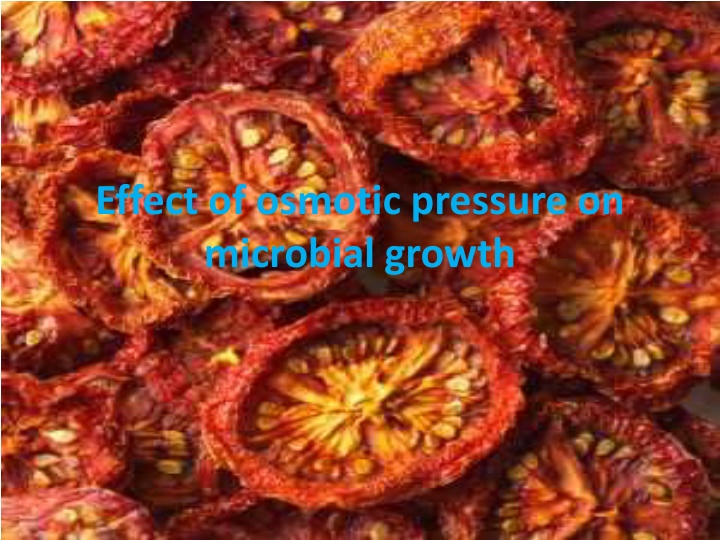
Impact of Osmotic Pressure on Microbial Growth
Explore the effects of osmotic pressure on microbial growth, osmosis, hypertonic and hypotonic solutions, and the inhibition of microbial growth through controlling water content in food preservation techniques. Understand how different solutions impact cell membranes and the movement of water in living organisms.
Download Presentation

Please find below an Image/Link to download the presentation.
The content on the website is provided AS IS for your information and personal use only. It may not be sold, licensed, or shared on other websites without obtaining consent from the author. If you encounter any issues during the download, it is possible that the publisher has removed the file from their server.
You are allowed to download the files provided on this website for personal or commercial use, subject to the condition that they are used lawfully. All files are the property of their respective owners.
The content on the website is provided AS IS for your information and personal use only. It may not be sold, licensed, or shared on other websites without obtaining consent from the author.
E N D
Presentation Transcript
Effect of osmotic pressure on microbial growth
Osmosis Is the net movement of a solvent (water) in living organisms from a region concentration to a region concentration of of higher lower water water
Hypertonic solution Is any solution that has a higher osmotic pressure than another solution In the biological field, high osmotic pressure removes water from cell, causing shrinkage of cell membrane (Plasmolysis) In this environment, osmosis can cause cells to die from shriveling (Crenation)
At lower water content, microbial growth is inhibited and the enzymatic and non-enzymatic decay of food is slowed Therefore this method is used to control spoilage and microbial growth Most food preservation techniques used combine methods of Drying Sugar Salt Preservatives Refrigeration Acidity and others
Hypotonic solution Is any solution that has a lower osmotic pressure than another solution In the biological field, this generally refers to a solution that has less solute and more water than another solution
In most cases cell wall prevents excessive entry of water Microbe may lyses or burst if cell wall is weak or cells not bound by a rigid wall Such as red blood cells which may be burst in a medium of this kind This phenomenon termed as plasmoptysis
Isotonic solution Is any solution that has the same osmotic pressure across a semi permeable membrane This state allows for the free movement of water across the membrane concentration of solutes on either side of the membrane without changing the
Osmophiles Are those Microorganisms capable of living in moderate to high sugar concentrations
Halophiles Are those Microorganisms which require moderate to high salt concentrations Microorganisms that live in marine environments can tolerate high salt concentrations a. Extreme or Obligate Halophiles Require very high salt concentrations (20 to 30%) such as bacteria in Dead Sea and brine vats b. Facultative Halophiles Do not require high salt concentrations for growth, but tolerate 2% salt or more This idea has been well known for centuries where high salt content has been used to control the spoiling of food
Effects of Salt and Sugar The major effect of salt as a preservative is that it withdraws water from microorganisms if the external salt concentration is high enough, the microbes would shrivel and die Spores would not be killed but would not be able to germinate
Sodium chloride is the main ingredient used in the preservation of meats Salting meat draws water out and tying up the water within, making it unavailable for chemical reactions that cause decay High concentrations of salt also interfere with the replication of microorganisms
Salt curing frequently uses salts containing nitrates Nitrates act as antioxidants in preserved foods, preventing decay and spoilage through oxidation and free radical generation However, high consumption of preserved foods containing nitrates may be linked to a higher risk of cancer
Just like with salt, some forms of sugar can draw water out of food and tie up water within the food so it is not available for biochemical reactions According Organization, effective for preserving food while glucose is not to the Food and and sucrose Agriculture are fructose very
Procedure 1. Prepare one liter of medium, distribute it in to 5 flasks (200ml for each flask) 2. Prepare different concentration NaCl and sugar for each flask of media with NaCl as following: (0.5%, 5%, 10% and 15% NaCl) (0%, 1.5%, 3%, 4.5% and 6% sugar) 3. Sterilize the medium in autoclave 4. Pour the sterilized medium in to 5 sterilized Petri dishes (one plate for each concentration); allow the plate to become solidified
5. Divide each plate into 3 sections, by using sterilized loop 6. Inoculate each plate with culture of: fungi and bacteria 7. Incubate the plates at 25 C for 5-7 days (fungi) and 37 C for 48h (bacteria) 8. Record your results on the laboratory report






















